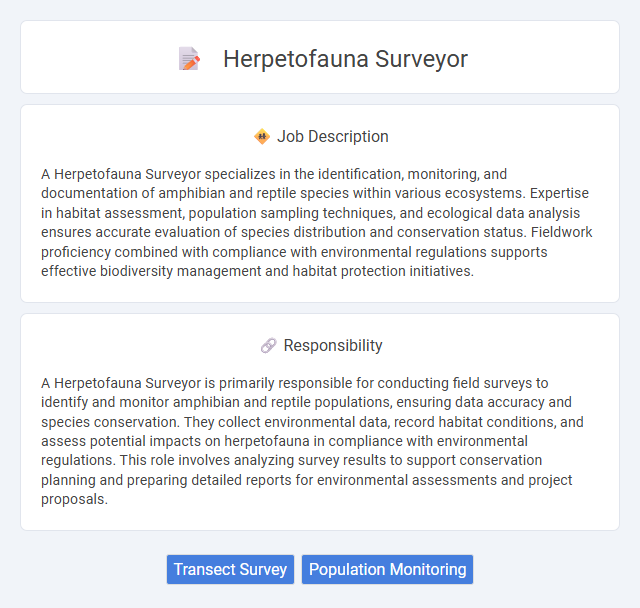
A Herpetofauna Surveyor specializes in the identification, monitoring, and documentation of amphibian and reptile species within various ecosystems. Expertise in habitat assessment, population sampling techniques, and ecological data analysis ensures accurate evaluation of species distribution and conservation status. Fieldwork proficiency combined with compliance with environmental regulations supports effective biodiversity management and habitat protection initiatives.
Individuals with a strong interest in reptiles and amphibians are likely suited for a Herpetofauna Surveyor role due to the job's demands for patience, keen observation, and physical stamina. Those comfortable working outdoors in variable weather conditions and able to navigate challenging terrains may find this position increasingly suitable. Candidates who prefer routine office work or have limited field mobility might face difficulties adjusting to the dynamic and physically active nature of the surveyor role.
Qualification
A Herpetofauna Surveyor must possess extensive knowledge of amphibian and reptile species identification and ecology, supported by a degree in environmental science, biology, or a related field. Proficiency in field survey techniques, including nocturnal surveys and habitat assessment, and experience with GPS mapping and data recording are essential for accurate monitoring and reporting. Strong analytical skills, physical fitness for rugged terrain, and relevant certifications, such as wildlife handling permits or ecological survey qualifications, enhance the candidate's suitability for this role.
Responsibility
A Herpetofauna Surveyor is primarily responsible for conducting field surveys to identify and monitor amphibian and reptile populations, ensuring data accuracy and species conservation. They collect environmental data, record habitat conditions, and assess potential impacts on herpetofauna in compliance with environmental regulations. This role involves analyzing survey results to support conservation planning and preparing detailed reports for environmental assessments and project proposals.
Benefit
A Herpetofauna Surveyor position likely offers valuable opportunities to contribute to wildlife conservation and biodiversity research. Candidates may gain hands-on experience with amphibians and reptiles while enhancing their field survey and data collection skills. This role probably provides a platform for professional growth within environmental science and ecological monitoring sectors.
Challenge
Herpetofauna surveyor roles likely present challenges such as navigating difficult terrain and unpredictable weather conditions to accurately monitor reptile and amphibian populations. Encountering elusive or nocturnal species may require advanced tracking skills and patience, increasing the complexity of fieldwork. Data collection accuracy may be affected by environmental variables, making adaptability and problem-solving essential for successful surveys.
Career Advancement
Herpetofauna surveyors contribute to critical ecological research by monitoring amphibian and reptile populations, which supports conservation efforts and environmental policy development. Career advancement opportunities include senior field biologist roles, environmental consultancy, and project management within wildlife agencies or research institutions. Gaining specialized certifications and expertise in habitat assessment enhances prospects for leadership positions and participation in large-scale biodiversity projects.
Key Terms
Transect Survey
A Herpetofauna Surveyor specializing in transect surveys systematically navigates predetermined paths to monitor amphibian and reptile populations. This method involves recording species presence, abundance, and habitat conditions along fixed lines, providing critical data for biodiversity assessments and conservation planning. Expertise in identifying herpetofaunal species and understanding microhabitat variations enhances the accuracy and reliability of transect survey results.
Population Monitoring
Herpetofauna surveyors specialize in population monitoring of amphibians and reptiles to assess species distribution, abundance, and health trends. They employ standardized field techniques such as visual encounter surveys, pitfall traps, and acoustic monitoring to gather quantitative data in various habitats. This systematic population monitoring supports conservation strategies and environmental impact assessments critical for biodiversity management.
 kuljobs.com
kuljobs.com